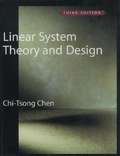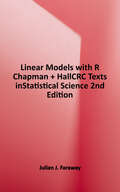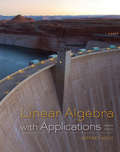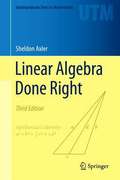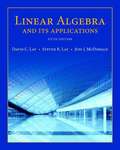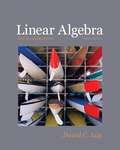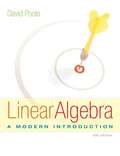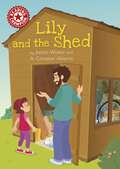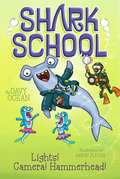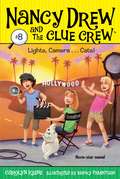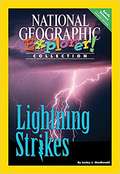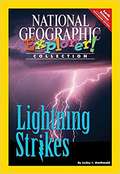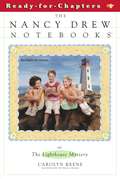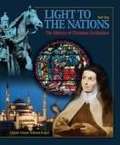- Table View
- List View
Linear System Theory and Design
by Chi-Tsong ChenAn extensive revision of the author's highly successful text, this third edition of Linear System Theory and Design has been made more accessible to students from all related backgrounds. After introducing the fundamental properties of linear systems, the text discusses design using state equations and transfer functions. In state-space design, Lyapunov equations are used extensively to design state feedback and state estimators. In the discussion of transfer-function design, pole placement, model matching, and their applications in tracking and disturbance rejection are covered. Both one-and two-degree-of-freedom configurations are used. All designs can be accomplished by solving sets of linear algebraic equations. <p><p> All results in this new edition are developed for numerical computation and illustrated using MATLAB, with an emphasis on the ideas behind the computation and interpretation of results. This book develops all theorems and results in a logical way so that readers can gain an intuitive understanding of the theorems. This revised edition begins with the time-invariant case and extends through the time-varying case. It also starts with single-input single-output design and extends to multi-input multi-output design. Striking a balance between theory and applications, Linear System Theory and Design, 3/e, is ideal for use in advanced undergraduate/first-year graduate courses in linear systems and multivariable system design in electrical, mechanical, chemical, and aeronautical engineering departments. It assumes a working knowledge of linear algebra and the Laplace transform and an elementary knowledge of differential equations.
Linear Models with R (Chapman & Hall/CRC Texts in Statistical Science)
by Julian J. FarawayA Hands-On Way to Learning Data Analysis <p><p> Part of the core of statistics, linear models are used to make predictions and explain the relationship between the response and the predictors. Understanding linear models is crucial to a broader competence in the practice of statistics. Linear Models with R, Second Edition explains how to use linear models in physical science, engineering, social science, and business applications. The book incorporates several improvements that reflect how the world of R has greatly expanded since the publication of the first edition. <p><p> New to the Second Edition <p><p> <p>•Reorganized material on interpreting linear models, which distinguishes the main applications of prediction and explanation and introduces elementary notions of causality <p>•Additional topics, including QR decomposition, splines, additive models, Lasso, multiple imputation, and false discovery rates <p>•Extensive use of the ggplot2 graphics package in addition to base graphics <p><p>Like its widely praised, best-selling predecessor, this edition combines statistics and R to seamlessly give a coherent exposition of the practice of linear modeling. The text offers up-to-date insight on essential data analysis topics, from estimation, inference, and prediction to missing data, factorial models, and block designs. Numerous examples illustrate how to apply the different methods using R.
Linear Algebra with Applications (Second Edition)
by Jeffrey HoltHolt's Linear Algebra with Applications, Second Edition, blends computational and conceptual topics throughout to prepare students for the rigors of conceptual thinking in an abstract setting. The early treatment of conceptual topics in the context of Euclidean space gives students more time, and a familiar setting, in which to absorb them. This organization also makes it possible to treat eigenvalues and eigenvectors earlier than in most texts. Abstract vector spaces are introduced later, once students have developed a solid conceptual foundation. <p><p> Concepts and topics are frequently accompanied by applications to provide context and motivation. Because many students learn by example, Linear Algebra with Applications provides a large number of representative examples, over and above those used to introduce topics. The text also has over 2500 exercises, covering computational and conceptual topics over a range of difficulty levels.
Linear Algebra Done Right
by Sheldon AxlerThis best-selling textbook for a second course in linear algebra is aimed at undergrad math majors and graduate students. The novel approach taken here banishes determinants to the end of the book. The text focuses on the central goal of linear algebra: understanding the structure of linear operators on finite-dimensional vector spaces. The author has taken unusual care to motivate concepts and to simplify proofs. A variety of interesting exercises in each chapter helps students understand and manipulate the objects of linear algebra. <p><p> The third edition contains major improvements and revisions throughout the book. More than 300 new exercises have been added since the previous edition. Many new examples have been added to illustrate the key ideas of linear algebra. New topics covered in the book include product spaces, quotient spaces, and dual spaces. Beautiful new formatting creates pages with an unusually pleasant appearance in both print and electronic versions. <p> No prerequisites are assumed other than the usual demand for suitable mathematical maturity. Thus the text starts by discussing vector spaces, linear independence, span, basis, and dimension. The book then deals with linear maps, eigenvalues, and eigenvectors. Inner-product spaces are introduced, leading to the finite-dimensional spectral theorem and its consequences. Generalized eigenvectors are then used to provide insight into the structure of a linear operator.
Linear Algebra and Its Applications, Fifth Edition
by David C. Lay Steven R. Lay Judi J. McdonaldWith traditional linear algebra texts, the course is relatively easy for students during the early stages as material is presented in a familiar, concrete setting. However, when abstract concepts are introduced, students often hit a wall. Instructors seem to agree that certain concepts (such as linear independence, spanning, subspace, vector space, and linear transformations) are not easily understood and require time to assimilate. These concepts are fundamental to the study of linear algebra, so students' understanding of them is vital to mastering the subject. This text makes these concepts more accessible by introducing them early in a familiar, concrete Rn setting, developing them gradually, and returning to them throughout the text so that when they are discussed in the abstract, students are readily able to understand.
Linear Algebra and Its Applications, 4th Edition
by David C. LayThis Fourth Edition provides a modern elementary introduction to linear algebra and a broad selection of interesting applications.
Linear Algebra
by Paul DawkinsFrom the author: Here are my online notes for my Linear Algebra course that I teach here at Lamar University. Despite the fact that these are my "class notes", they should be accessible to anyone wanting to learn Linear Algebra or needing a refresher. These notes do assume that the reader has a good working knowledge of basic Algebra. This set of notes is fairly self contained but there is enough Algebra type problems (arithmetic and occasionally solving equations) that can show up that not having a good background in Algebra can cause the occasional problem.
Linear Algebra: A Modern Introduction
by David PooleThis fourth edition emphasizes a vectors approach and better prepares students to make the transition from computational to theoretical mathematics. Balancing theory and applications, the book is written in a conversational style and combines a traditional presentation with a focus on student-centered learning. Theoretical, computational, and applied topics are presented in a flexible yet integrated way. Stressing geometric understanding before computational techniques, vectors and vector geometry are introduced early to help students visualize concepts and develop mathematical maturity for abstract thinking. Additionally, the book includes ample applications drawn from a variety of disciplines, which reinforce the fact that linear algebra is a valuable tool for modeling real-life problems.
Line in the Sand: Preserving Bedouin Culture (Fountas & Pinnell Classroom, Guided Reading Grade 6)
by Amanda YskampNIMAC-sourced textbook
Lincoln-Douglas Debate: Values in Conflict (2nd edition)
by Jeffrey Wiese Stan LewisThis book examines the history and nature of Lincoln-Douglas debate in society and introduces value debate by comparing and contrasting it with policy debate.
Lily's New Game (Fountas & Pinnell Classroom, Guided Reading Grade 3)
by Leslie Budnick Jimmy HolderNIMAC-sourced textbook
Lily's Grouchy Day (Fountas & Pinnell Classroom, Guided Reading Grade 3)
by Leslie Budnick Jimmy HolderNIMAC-sourced textbook
Lily's Amazing Hair (Fountas & Pinnell Classroom, Guided Reading Grade 3)
by Leslie Budnick Jimmy HolderNIMAC-sourced textbook
Lily y su bolso de plástico morado (¡Arriba la Lectura!, Trade Book #11)
by Kevin HenkesNIMAC-sourced textbook
Lily and the Shed: Independent Reading Red 2 (Reading Champion #516)
by Jackie WalterThis story is part of Reading Champion, a series carefully linked to book bands to encourage independent reading skills, developed with Dr Sue Bodman and Glen Franklin of UCL Institute of Education (IOE)Lily and the Shed shows a girl determined to make the perfect den in an old shed - and with some hard work, she gets it just right!Reading Champion offers independent reading books for children to practise and reinforce their developing reading skills.Fantastic, original stories are accompanied by engaging artwork and a reading activity. Each book has been carefully graded so that it can be matched to a child's reading ability, encouraging reading for pleasure. Perfect for 4-5 year olds or those reading book band red 2.
Lights! Camera! Hammerhead! (Shark School #2)
by Aaron Blecha Davy OceanHarry has hopes of hammerhead stardom in this second book of a fin-tastic chapter book series. <P><P>When humans show up at Shark Point to film an underwater documentary, Harry Hammer is thrilled. He's sure he's meant for the spotlight, but will he end up with the starring role of his dreams, or stay in deep-sea oblivion?
Lights, Camera ... Cats! (Nancy Drew and the Clue Crew #8)
by Carolyn Keene Macky PamintuanThe Clue Crew is seeing stars! Look out -- the Clue Crew is headed to Hollywood! Carson Drew's client invited him to the set of a new movie -- starring the most famous cat in Hollywood, Fluffington! <P><P>The girls are thrilled when Mr. Drew asks them to come along. They get their first taste of a real movie set and are even cast as extras in the film. Plus they get to pet Fluffington as much as they want. But then Fluffington vanishes. <P><P>When no one can find the famous feline, the Clue Crew springs into action -- because a movie is not a movie without its star!
Lights, Camera, Action: How to Make a Video (Fountas & Pinnell Classroom, Guided Reading Grade 6)
by Margie SigmanNIMAC-sourced textbook
Lightning Strikes, Pioneer Edition (National Geographic Explorer Collection)
by Lesley J. MacDonaldNIMAC-sourced textbook
Lightning Strikes, Pathfinder Edition (National Geographic Explorer Collection)
by Lesley J. MacDonaldNIMAC-sourced textbook
The Lighthouse Mystery (The Nancy Drew Notebooks #60)
by Carolyn Keene Paul CasaleNancy and her friends are on a fun-filled trip to the coast of Maine. But when the historic town lighthouse starts flashing strange signs, Nancy and the girls investigate the lore surrounding the lighthouse. Illustrations. Picture descriptions present.
Light Waves: Skin Cancer in Australia, Investigation Notebook with Article Compilation
by The Lawrence Hall of ScienceNIMAC-sourced textbook
Light to the Nations: The History of Christian Civilization, Part 1
by Rollin A. Lasseter Christopher Zehnder Michael J. Van HeckeA Christian interpretation of history is the story of God's love for mankind. As a long and complex story, it can tell of tragedies as well as comedies, of famines as well as feasts, of exiles and homecomings, defeats and victories.
